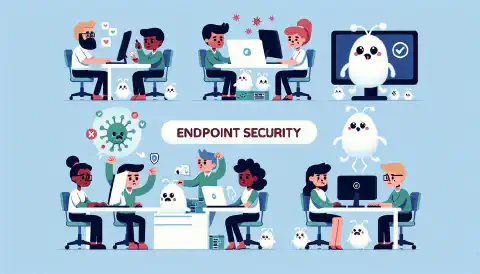Mastering Cybersecurity: Your Guide to a Safer Digital World

Table of Contents
Cybersecurity For Beginners: A Non-Technical Guide to Understanding Cybersecurity Basics
In today’s digital age, where technology plays a crucial role in every aspect of our lives, understanding cybersecurity is more important than ever. Cybersecurity is the practice of protecting computers, servers, networks, and other digital assets from unauthorized access, attacks, and damage. It encompasses a wide range of measures and techniques designed to ensure the confidentiality, integrity, and availability of sensitive information.
Understanding the Importance of Cybersecurity
In the interconnected world we live in, where information travels at the speed of light, the importance of cybersecurity cannot be overstated. Cyber threats are constantly evolving, becoming more sophisticated and damaging with each passing day. It is essential for individuals, businesses, and organizations to understand the role that cybersecurity plays in safeguarding their digital assets and protecting their sensitive information. Without proper cybersecurity measures in place, the consequences can be severe, including financial losses, reputational damage, and legal repercussions.
Furthermore, cybersecurity is no longer just a concern for IT professionals. It affects everyone, from individuals who use the internet for personal transactions and socializing to businesses that rely on digital infrastructure for their operations. Understanding the basics of cybersecurity can empower individuals and organizations to take proactive measures to protect themselves from cyber threats.
One of the key aspects of cybersecurity is the protection of personal information. In today’s digital age, our personal information is more vulnerable than ever before. Cybercriminals are constantly on the lookout for ways to exploit this information for their own gain. From credit card details to social security numbers, our personal data is a valuable commodity in the cybercrime underworld.
With the increasing reliance on digital platforms for financial transactions, it is crucial to understand the risks involved. Cybercriminals employ various techniques such as phishing, malware, and ransomware to gain unauthorized access to sensitive information. By understanding these tactics, individuals can be more vigilant and avoid falling victim to such scams.
Moreover, cybersecurity is not just about protecting personal information. It also plays a crucial role in safeguarding businesses and organizations. In today’s digital landscape, businesses store vast amounts of data, ranging from customer information to trade secrets. A breach in cybersecurity can have devastating consequences, leading to financial losses, loss of customer trust, and even bankruptcy.
To mitigate these risks, businesses need to invest in robust cybersecurity measures. This includes implementing firewalls, encryption protocols, and intrusion detection systems. Additionally, regular security audits and employee training programs can help create a culture of cybersecurity awareness within the organization.
Another important aspect of cybersecurity is the protection of critical infrastructure. From power grids to transportation systems, many essential services rely on interconnected networks. A cyber attack on these systems can have catastrophic consequences, disrupting daily life and causing widespread chaos.
Understanding the potential impact of cyber threats on critical infrastructure is essential for governments and policymakers. By investing in cybersecurity measures, such as network monitoring and incident response plans, they can ensure the resilience of these vital systems.
In conclusion, cybersecurity is a critical concern in today’s digital world. It is not just a responsibility for IT professionals but for everyone who uses the internet. By understanding the importance of cybersecurity and taking proactive measures to protect ourselves and our digital assets, we can contribute to a safer and more secure online environment.
Basic Concepts of Cybersecurity
Before delving into the types of cyber threats and cybersecurity best practices, it is important to grasp the fundamental concepts of cybersecurity. At its core, cybersecurity is about protecting digital assets from unauthorized access, use, disclosure, disruption, modification, or destruction.
Cybersecurity encompasses a wide range of security practices, including network security, data security, application security, and operational security. It involves implementing mechanisms and measures to prevent, detect, and respond to cyber attacks.
Key Terms and Definitions in Cybersecurity
It is essential to familiarize yourself with some key terms and definitions commonly used in the field of cybersecurity. This will enable you to better understand and navigate the complexities of the subject matter.
Threat: A potential danger or risk that could exploit a vulnerability and compromise the confidentiality, integrity, or availability of digital assets.
Vulnerability: A weakness or gap in security that can be exploited by threats.
Risk: The potential for loss or harm resulting from a cyber attack or unauthorized access.
Exploit: A technique or piece of software used to take advantage of a vulnerability in a computer system.
Zero-day: A vulnerability that is unknown to software vendors and has not yet been patched or fixed.
Now that we have established the basic concepts of cybersecurity, let’s dive deeper into each of the key terms and definitions mentioned above.
Threats in Cybersecurity
Threats in cybersecurity come in various forms, ranging from malicious software (malware) to hackers attempting to gain unauthorized access to sensitive information. It is crucial to identify and understand these threats to effectively protect digital assets.
One common threat is malware, which includes viruses, worms, trojans, and ransomware. These malicious programs are designed to infiltrate computer systems, steal data, or cause disruption. Understanding the different types of malware and their behaviors is essential in developing effective defense mechanisms.
Another significant threat is social engineering, which involves manipulating individuals to gain unauthorized access or divulge sensitive information. Social engineering techniques can include phishing emails, pretexting, baiting, or even impersonating trusted individuals or organizations.
Other threats include denial-of-service (DoS) attacks, where attackers overwhelm a system or network with excessive traffic, rendering it unavailable to legitimate users. Additionally, advanced persistent threats (APTs) are sophisticated, prolonged cyber attacks targeting specific organizations or individuals.
Vulnerabilities and Risks in Cybersecurity
Vulnerabilities are weaknesses or gaps in security that can be exploited by threats. Identifying and addressing vulnerabilities is crucial to minimize the risk of cyber attacks.
Software vulnerabilities are common targets for cybercriminals. Operating systems, applications, or plugins that are not regularly updated with security patches are vulnerable to exploitation. This is why keeping software up to date is essential in maintaining a secure digital environment.
Human error can also introduce vulnerabilities. Weak passwords, sharing sensitive information, or falling victim to social engineering tactics can compromise the security of digital assets. Educating users on best practices and implementing strong authentication mechanisms can help mitigate these risks.
Risks in cybersecurity refer to the potential for loss or harm resulting from a cyber attack or unauthorized access. Assessing and managing these risks is crucial to develop effective cybersecurity strategies.
Exploits and Zero-day Vulnerabilities
Exploits are techniques or pieces of software used to take advantage of vulnerabilities in computer systems. Cybercriminals often use exploits to gain unauthorized access, steal data, or disrupt operations.
Zero-day vulnerabilities are particularly concerning as they are unknown to software vendors and have not yet been patched or fixed. This means that cybercriminals can exploit these vulnerabilities without detection, making them highly valuable in the cybercriminal underground.
Discovering and patching zero-day vulnerabilities is a constant challenge for software vendors and security researchers. Timely identification and remediation of these vulnerabilities are essential to prevent potential cyber attacks.
Understanding the concepts of threats, vulnerabilities, risks, exploits, and zero-day vulnerabilities is fundamental in developing effective cybersecurity strategies. By staying informed and vigilant, individuals and organizations can better protect their digital assets from cyber threats.
Types of Cyber Threats
Now that we have established the importance of cybersecurity and the basic concepts involved, let’s explore some of the common types of cyber threats that individuals and organizations face on a daily basis.
In today’s interconnected world, the threat landscape for cyber attacks is constantly evolving. Cybercriminals are becoming more sophisticated, using advanced techniques to exploit vulnerabilities and gain unauthorized access to sensitive information. Understanding the different types of cyber threats is crucial in order to protect ourselves and our digital assets.
Understanding Malware: Viruses, Worms, and Trojans
One of the most prevalent forms of cyber threats is malware, which refers to any software designed to gain unauthorized access to or damage a computer system, network, or device. Malware comes in various forms, including viruses, worms, and Trojans.
A virus is a type of malware that spreads by attaching itself to other files or programs. It can replicate and spread to other computers, causing harm to the infected system. Viruses can be transmitted through email attachments, infected websites, or even removable storage devices.
Worms, on the other hand, are self-replicating malware that do not require user interaction to spread. They can exploit vulnerabilities in computer systems and spread across networks, causing widespread damage. Worms can quickly infect multiple devices within a network, leading to disruptions in services and compromising sensitive data.
Trojans, named after the infamous Trojan horse, are a type of malware that disguises itself as legitimate software or files, tricking users into downloading or executing it. Once activated, a Trojan can provide unauthorized access to the attacker or cause other malicious activities. Trojans can be hidden within seemingly harmless files, such as games or software updates, making them difficult to detect.
The Danger of Phishing and Social Engineering Attacks
Another common type of cyber threat is phishing. Phishing attacks involve tricking individuals into providing sensitive information, such as usernames, passwords, and credit card details, by posing as trustworthy entities. These attacks often come in the form of deceptive emails, websites, or instant messages that appear to be from legitimate sources.
Phishing attacks can be highly convincing, using social engineering techniques to manipulate victims into revealing their personal information. Cybercriminals may create fake login pages that resemble popular websites, making it difficult for users to differentiate between the real and fake ones. They may also employ urgency or fear tactics, such as claiming that an account has been compromised, in order to prompt immediate action.
Social engineering attacks, on the other hand, exploit human psychology and manipulate individuals into divulging sensitive information or performing actions that may compromise security. This can include impersonating technical support personnel, using pretexting to gain trust, or exploiting the fear of consequences. These attacks target the human element of cybersecurity, taking advantage of trust, curiosity, or fear to bypass technical security measures.
Phishing and social engineering attacks are particularly dangerous because they rely on human error and can bypass technical security measures. It is important to be vigilant and cautious when interacting with online messages, emails, and websites to prevent falling victim to these types of attacks. Regularly updating passwords, enabling multi-factor authentication, and being skeptical of unsolicited requests for personal information are some of the best practices to protect against these threats.
As technology continues to advance, the landscape of cyber threats will continue to evolve. It is crucial for individuals and organizations to stay informed about the latest threats and take proactive measures to safeguard their digital assets. By understanding the different types of cyber threats and implementing effective security measures, we can better protect ourselves and our digital lives.
Principles of Cybersecurity
Now that we have a better understanding of some common types of cyber threats, let’s explore the principles and concepts that form the foundation of cybersecurity.
Confidentiality, Integrity, and Availability: The CIA Triad
The CIA triad is a fundamental concept in cybersecurity that represents the three primary objectives of information security: confidentiality, integrity, and availability.
- Confidentiality refers to ensuring that sensitive information is not disclosed to unauthorized individuals, protecting its privacy and maintaining secrecy.
- Integrity ensures that information remains accurate, consistent, and trustworthy throughout its lifecycle. Techniques such as data validation, checksums, and digital signatures are used to maintain the integrity of information.
- Availability ensures that information and services are accessible and usable when needed. This requires protecting against service disruptions, system failures, and denial-of-service attacks.
The Role of Authentication and Authorization
Authentication and authorization are crucial components of any cybersecurity framework, ensuring that only authorized individuals have access to sensitive information and resources.
- Authentication verifies the identity of users, ensuring they are who they claim to be. This can be done through various mechanisms, such as passwords, biometrics, or two-factor authentication.
- Authorization determines what actions and resources a user is allowed to access based on their authenticated identity. This involves assigning permissions and privileges to prevent unauthorized access and ensure the principle of least privilege.
Cybersecurity Best Practices
Now that we have covered the basics of cybersecurity and explored different types of cyber threats, it is important to discuss some best practices that can help individuals and organizations enhance their security posture.
Creating Strong Passwords and Using Password Managers
One of the simplest yet most effective ways to improve cybersecurity is to create and use strong passwords. A strong password should be unique, complex, and difficult to guess. It should include a combination of uppercase and lowercase letters, numbers, and special characters. Passwords should also be regularly changed.
Furthermore, managing multiple passwords can be challenging. Using a password manager can simplify the process by securely storing and generating strong passwords for different accounts. This eliminates the need to remember multiple passwords and reduces the risk of password reuse.
The Importance of Regular Software Updates
Regularly updating software and applications is critical for maintaining cybersecurity. Software updates often include security patches that address known vulnerabilities and protect against potential cyber threats.
Software vulnerability is a weakness or flaw in a software program that can be exploited by cybercriminals to gain unauthorized access or control over a system. Patches and updates are released by software vendors to fix these vulnerabilities and improve the security of their products.
By keeping software and applications up to date, individuals and organizations can ensure they have the latest security features and protection against emerging cyber threats.
Conclusion
To conclude, understanding the basics of cybersecurity is essential in today’s digital age. By grasping the importance of cybersecurity, familiarizing yourself with the common types of cyber threats, and implementing best practices, you can significantly enhance your security posture and protect yourself from potential cyber attacks. Remember, cybersecurity is a constant battle, requiring ongoing vigilance and proactive measures to stay ahead of cybercriminals. Stay informed, stay secure!






